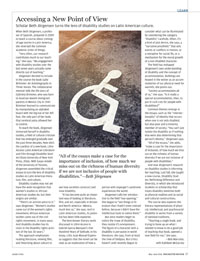In Review
 (Photo: Adobe Stock)
(Photo: Adobe Stock)When Beth Jörgensen, a professor of Spanish, prepared in 2009 to teach a course about coming-of-age stories in Latin America, she reversed the common academic order of things.
“Very often, our research contributes much to our teaching,” she says. “My engagement with disability studies over the last seven years actually came directly out of teaching.”
Jörgensen decided to include in the course the book Gaby Brimmer: An Autobiography in Three Voices. The collaborative memoir tells the life story of Gabriela Brimmer, who was born to Austrian-Jewish immigrant parents in Mexico City in 1947. Brimmer learned to communicate by manipulating an alphabet board with the big toe of her left foot, the only part of her body that cerebral palsy allowed her to control.
To teach the book, Jörgensen immersed herself in disability studies, a field of cultural criticism that has emerged gradually over the past three decades. Now she’s the coeditor of a new book, Libre Acceso: Latin American Literature and Film through Disability Studies (State University of New York Press, 2016). With Susan Antebi of the University of Toronto, Jörgensen assembled the critical essays to turn the lens of disability studies on Latin American literature, film, and culture.
Disability studies may not yet have the wide recognition that women’s studies or African-American studies do, but their origins are similar.
“There’s an activist piece to it,” says Jörgensen. “Women’s studies came out of the women’s rights movement; African-American studies came out of the civil rights movement, in many ways. And disability studies has its roots in the disability rights activism of the last 30 years.”
The approach emphasizes reading literature, viewing film, and theorizing about culture to see how societies construct and view disability.
“It has become quite an important way of looking at literature, film, and art, especially in Britain and North America—Mexico, much less so,” she says. And in Latin American studies, its potential has been little explored.
The best-known literary work discussed in Libre Acceso is Gabriel Garcia Márquez’s One Hundred Years of Solitude. In his essay, critic Juan Manuel Espinosa suggests that the novel can be read as an exploration of how a person with Asperger’s syndrome experiences the world.
Jörgensen calls her introduction to the field “eye-opening.” She began to “see things in literature that I hadn’t even noticed before, because I didn’t have the intellectual tools to notice them.”
But once readers begin to notice the trope of disability, they realize it’s omnipresent. The figure of a character with a disability is pervasive in world literature, she says, from at least the time of Oedipus. But critics haven’t until recently begun to consider what can be illuminated by considering the category “disability” carefully. Often, it’s a kind of plot device, she says, a “narrative prosthetic” that sets events or conflicts in motion, or a metaphor for social ills, or a mechanism for the moral growth of a non-disabled character.
The field has reshaped Jörgensen’s own understanding of disability and the concept of accommodation. Buildings are heated in the winter as an accommodation of our physical need for warmth, she points out.
“Society accommodates all of us,” she says. “Is it really a special accommodation, then, to put in curb cuts for people with disabilities?”
Common themes emerge in the essays, such as the “intersectionality” of identity that occurs when one is not only disabled, but also poor and a minority member of society. “You can’t just isolate the disability as if nothing else were also determining that person’s destiny,” Jörgensen says.
“All of the essays,” she adds, “make a case for the importance of inclusion, of how much we miss out on the richness of human diversity if we are not inclusive of people with disabilities.”
And now Jörgensen’s research on disability studies is informing her teaching. Last fall, she taught a new course, Disability Studies: Rethinking Difference and Diversity, in which she introduced students to scholarship that treats disability identities both as physical realities and as social and cultural constructions.
The course also explores the literary representations of physical, intellectual, and psychosocial disability in works from a variety of national traditions.
“Teaching a single book, and trying to bone up on what I needed to know to do a good job of teaching that book, opened a new field for me,” she says.
—Bob Marcotte, with Kathleen McGarvey

